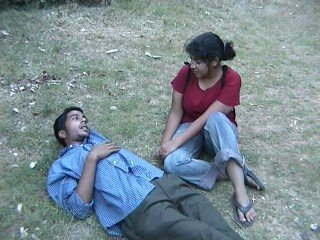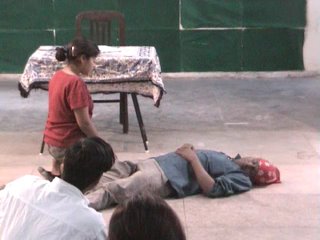No Motive...Story 1: ActorCharactersPlay Director
Director’s assistant (f)
ACTOR
Drunkard
Characters inside Play-within-playActors – Shiva, Vella, Nagan
Actress(f)
Musicians – Violinist, Drummer, Pianist.
Synopsis of the filmA drama rehearsal forms the immediate context of the story. A drama troupe is trying to rehearse some scenes of their play which is structurally inspired from Anton Chekov’s famous short story ‘The Bet’. The film tries to depict some minutes in the life of the lead actor of the play (glossed as ACTOR). He performs onstage murder successfully (signified by the tandava dance sequence), while he turns out to be an utter failure while enacting the suicide scene.
The drama rehearsal starts. All the actors are dressed in casuals. There is casual banter among the actors about the plagiarized nature of the play, the scriptwriter’s idiosyncrasies while composing the lines and general bitching. The tone is very cynical, sarcastic. Crucially, the ACTOR does not participate in this. At this point a drunkard enters the rehearsal set and interrupts the proceedings. He is a personal friend of the director. From his slurred speech, it is evident that he is the ex-lover of the director’s assistant and the girl has recently walked out of the relationship. The director lends a sympathetic ear to his friend’s predicament. More importantly, the ACTOR intently listens to the exchange and is affected/disturbed emotionally. The director gently coaxes the drunkard into a seat and calls for the resumption of on-stage proceedings. They enact the drama till the the murder-tandava scene in the play. The ACTOR carries on with renewed vigour and tempo and successfully enacts the dance of murder
Now the director calls a drinks break and tea is served. The actors jump off the stage. At this point the director’s assistant moves towards the ACTOR and starts a conversation with him. She is intrigued by the dichotomy between character and actor and how ACTOR copes up with the ethical, aesthetic challenges that a prosthetic, diegetic device like the bet entails. She is interested in knowing the ACTOR’s actual position viz-a-viz the murder-suicide question. On the contrary, the ACTOR sees this just as a problem of histrionics ie, how faithfully can the poseur in him actualize a performance which is successful. The two really straddle incommensurable paradigms. Instead the ACTOR is more interested in the factual details of the assistant’s failed romance. But whatever be the trajectories of the two, there is an attraction between them.
The director now calls for a rehearsal of the suicide scene. The ACTOR walks up to the stage confidently. He is patently unable to bring out a suicide which can satisfy either himself or the director. Even after a second take, it looks as if the task is beyond him. Dejectedly, he climbs off the stage.
The actor in his walk in the aisle throws down his bandana and turns his back to the whole. The other actors are uninterested and wait for the next thing while the director is resigned and tired and turns back to his friend. But crucially there is no banter this time. Now very slowly the drunkard comes on his own and takes the bandana thrown aside by the ACTOR and adorns it. He walks up to the stage slowly and takes stance. The drunkard gives a successful rendering of the suicide in a single take and falls to the floor. The otherwise uninterested supporting cast is dumbstruck by the performance and their gaze is rooted on to the fallen figure of the drunkard. The musicians’ gaze is also riveted to the fallen figure and they have stopped playing their notes. From the gallery, the ACTOR also watches the show and is visibly depressed. The director’s assistant now climbs on to the stage for the first time and stoops down to the drunkard.
Suddenly the director shouts into the silence, “Aree baaaand bajaooo…” and musicians burst forth into a happy chord.
Synopsis of the play within the film The play deals with an unnatural, incongruous bet which is placed between the ACTOR and the rest of the supporting characters. The question being mooted is: ‘Which is more easy – Killing oneself or killing the Other?’ (The choice being between murder and suicide and the result being death in either formulation). Goaded by taunts on his own virility (namely suicide as the path of cowards and murder as the path of men), the hapless hero accepts the wager.






